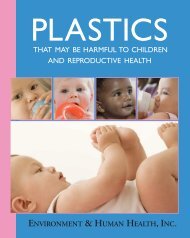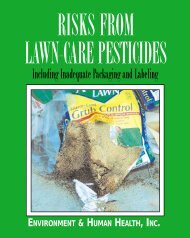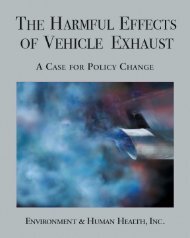LEED Report - Environment & Human Health, Inc.
LEED Report - Environment & Human Health, Inc.
LEED Report - Environment & Human Health, Inc.
- No tags were found...
You also want an ePaper? Increase the reach of your titles
YUMPU automatically turns print PDFs into web optimized ePapers that Google loves.
The Green Building DebateEach step carries additional risks if label warnings and direc tions are notfollowed perfectly or if other mistakes occur. In addition, children’sexposure to pesticides applied outdoors may be much greater thanthose of adults: they love to roll, play and sit in the grass, and they enjoytouching and smelling colorful ornamental shrubs and flowers, whichare sprayed more often than other plants.A recent EPA survey found that 75 percent of U.S. households used atleast one pesticide product indoors during the past year. Another studysuggests that 80 percent of most people’s exposure to pesticides occursindoors and that measurable levels of up to a dozen pesticides havebeen found in the air inside homes. 12The Green Building Council’s commitment to pesticide reduction inbuildings is weak at best, relying on Integrated Pest Management (IPM),a pest management approach that means different things to differ entpeople. When the Government Accounting Office examined the statusof IPM adoption in the United States, it discovered that the implementationrate “is a misleading indicator of the progress made toward anoriginal purpose of IPM—reducing chemical pesticide use.”IPM includes a wide variety of pest management practices, withoutdistinguishing between those that tend to reduce chemical pesticideuse and those that may not. The Green Building Council’s currentreliance on IPM provides little assurance of health protection frompesticides used indoors. 13 There is little necessary governmentoversight to assure compliance with performance standards.The U.S. Green BuildingCouncil’s commitment topesticide reduction inbuildings is weak at best,relying on Integrated PestManagement (IPM), a pestmanagement approachthat means different thingsto different people.IPM originated with chemical manufacturers, formulators andapplicators who hoped the standard would be accepted by EPA as analternative to stricter federal regulations that might limit pesticide useand residues in air, water and food. Thus <strong>LEED</strong>’s offer of 2 credits foremploying IPM standards provides little assurance of pesticide exposurereduction.25







